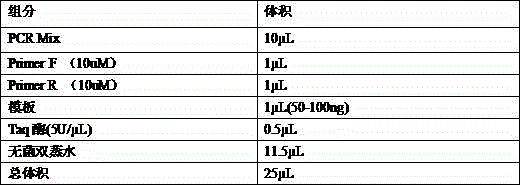Detecting method for safely and quickly identifying porcine-derived materials in food and kit for detecting method
A detection kit and detection method technology are applied in the field of detection methods and kits for the safe and rapid identification of porcine-derived components in food, which can solve problems such as the inability to meet the needs of meat product species identification, and achieve reliable technical support, The effect of increased sensitivity, speed and accuracy
- Summary
- Abstract
- Description
- Claims
- Application Information
AI Technical Summary
Problems solved by technology
Method used
Image
Examples
Embodiment 1
[0048] A detection method for safely and quickly identifying pig-derived components in food, specifically comprising the following steps:
[0049] (1) Design primers: Design pig-specific primers that can only amplify pig mitochondrial DNA. The specific primers include upstream primers and downstream primers, and their sequences are as follows:
[0050] Upstream primer F: 5-ATGAAACATTGGAGTAGTCCTACTATTTACC-3;
[0051] Downstream primer R: 5-CTACGAGGTCTGTTCCGATATAAGG-3;
[0052] (2) Template DNA extraction: The template DNA was extracted by the phenol-chloroform method, and detected by agarose electrophoresis with a mass fraction of 0.8%, and the extracted template DNA was stored at -20°C;
[0053] (3) PCR amplification primers and reaction system: The total reaction system is 25uL, including 12.5uL of PCRMix, 2.5pmol / L each of the upstream primer and downstream primer prepared in step (1), 1μL each, and the template DNA extracted in step (2) 50~ 100ng, water supplement;
[00...
Embodiment 2
[0058] A detection kit for safe and rapid identification of pig-derived components in food, including specific primers, DNA extraction reagents, PCRMix and water. After the four substances are mixed, the total volume of the PCR reaction system mixture is 25uL. Wherein, the specific primers include upstream primers and downstream primers, 1 uL each of the upstream primers and downstream primers; the DNA extraction reagents include five parts of A solution, B solution, C solution, D solution, and E solution. 1ml of solution A; the amount of PCRMix used is 12.5ul; water makes up the rest.
[0059] The PCRMix in the PCR reaction system mixed solution is 0.5 times of the total mixed solution volume; the upstream primer and the downstream primer are each 1 / 25 of the total mixed solution volume; the total amount of DNA is 50-100ng; if the volume of the above components is insufficient The total volume, the insufficient part can be made up with water. Among them, PCRMix is the PCR ...
Embodiment 3
[0073] The method of using the detection kit of the above-mentioned embodiment 2 is as follows:
[0074] (1) Use of DNA extraction reagents:
[0075] (1) Cut the sample to be tested into pieces, add 1ml of A solution per gram of sample, vortex for 30 seconds, place at room temperature for 5 minutes, and centrifuge at 12000rpm for 3 minutes, take the supernatant into a new centrifuge tube;
[0076] (2) Add the supernatant (500ul-800ul) obtained in step (1) into 500ul of B solution, mix it upside down, centrifuge at 12000rpm for 3 minutes, and take the supernatant into a new centrifuge tube;
[0077] (3) Add an equal volume of C solution to the supernatant obtained in step (2) (the amount used is the same volume as the supernatant obtained in step (2), for example: the supernatant obtained after centrifugation in step (2) is 300ul, then add C liquid is 300ul), invert and mix well, centrifuge at 12000rpm for 3 minutes, take the supernatant into a new centrifuge tube;
[0078] (...
PUM
 Login to View More
Login to View More Abstract
Description
Claims
Application Information
 Login to View More
Login to View More - R&D Engineer
- R&D Manager
- IP Professional
- Industry Leading Data Capabilities
- Powerful AI technology
- Patent DNA Extraction
Browse by: Latest US Patents, China's latest patents, Technical Efficacy Thesaurus, Application Domain, Technology Topic, Popular Technical Reports.
© 2024 PatSnap. All rights reserved.Legal|Privacy policy|Modern Slavery Act Transparency Statement|Sitemap|About US| Contact US: help@patsnap.com










